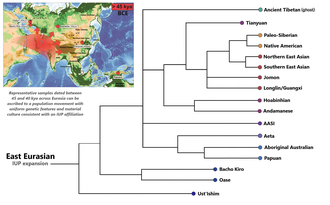
The Nganasans are a Uralic people of the Samoyedic branch native to the Taymyr Peninsula in north Siberia. In the Russian Federation, they are recognized as one of the Indigenous peoples of the Russian North. They reside primarily in the settlements of Ust-Avam, Volochanka, and Novaya in the Taymyrsky Dolgano-Nenetsky District of Krasnoyarsk Krai, with smaller populations residing in the towns of Dudinka and Norilsk as well.

Tungusic peoples are an ethnolinguistic group formed by the speakers of Tungusic languages. They are native to Siberia, China, and Mongolia.
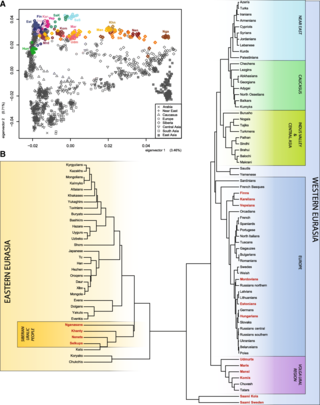
Genetic studies on Sami is the genetic research that have been carried out on the Sami people. The Sami languages belong to the Uralic languages family of Eurasia.
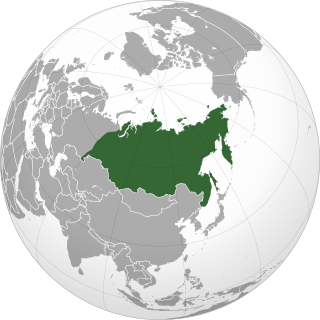
Siberia is a vast region spanning the northern part of the Asian continent and forming the Asiatic portion of Russia. As a result of the Russian conquest of Siberia and of the subsequent population movements during the Soviet era (1917–1991), the modern-day demographics of Siberia is dominated by ethnic Russians (Siberiaks) and other Slavs. However, there remains a slowly increasing number of Indigenous groups, accounting for about 5% of the total Siberian population, some of which are closely genetically related to Indigenous peoples of the Americas.
Tianyuan man are the remains of one of the earliest modern humans to inhabit East Asia. In 2007, researchers found 34 bone fragments belonging to a single individual at the Tianyuan Cave near Beijing, China. Radiocarbon dating shows the bones to be between 42,000 and 39,000 years old, which may be slightly younger than the only other finds of bones of a similar age at the Niah Caves in Sarawak on the South-east Asian island of Borneo.

In the course of the peopling of the World by Homo sapiens, East Asia was reached about 50,000 years ago. The "recent African origin" lineage of 70 kya diverged into identifiable East Eurasian and West Eurasian lineages by about 50 kya. This early East Asian lineage diverged further during the Last Glacial Maximum, contributing outgoing from Mainland Southeast Asia significantly to the peopling of the Americas via Beringia about 25 kya. After the last ice age China became cut off from neighboring island groups. The previous phenotypes of early East Asians became either replaced or prevailed among more geographically distant groups.
The Glazkov culture, Glazkovo culture, or Glazkovskaya culture, was an archaeological culture in the Lake Baikal area during the Early Bronze Age.

The Mongolic peoples are a collection of East Asian-originated ethnic groups in East, North, South Asia and Eastern Europe, who speak Mongolic languages. Their ancestors are referred to as Proto-Mongols. The largest contemporary Mongolic ethnic group is the Mongols. Mongolic-speaking people, although distributed in a wide geographical area, show a high genetic affinity to each other, and display continuity with ancient Northeast Asians.
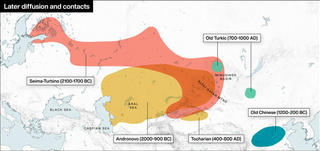
The Seima-Turbino culture, also Seima-Turbinsky culture or Seima-Turbino phenomenon, is a pattern of burial sites with similar bronze artifacts. Seima-Turbino is attested across northern Eurasia, particularly Siberia and Central Asia, maybe from Fennoscandia to Mongolia, Northeast China, Russian Far East, Korea, and Japan. The homeland is considered to be the Altai Mountains. These findings have suggested a common point of cultural origin, possession of advanced metal working technology, and unexplained rapid migration. The buried were nomadic warriors and metal-workers, traveling on horseback or two-wheeled carts.

The Mal'ta–Buret' culture is an archaeological culture of the Upper Paleolithic. It is located roughly northwest of Lake Baikal, about 90km to the northwest of Irkutsk, on the banks of the upper Angara River.

The Slab-grave culture is an archaeological culture of Late Bronze Age and Early Iron Age Mongolia. The Slab-Grave culture formed one of the primary ancestral components of the succeeding Xiongnu, as revealed by genetic evidence. The ethnogenesis of Turkic peoples and the modern Mongolian people is, at least partially, linked to the Slab-Grave culture by historical and archaeological evidence and further corroborated by genetic research on the Slab Grave remains.

The Proto-Uralic homeland is the hypothetical place where speakers of the Proto-Uralic language lived in a single linguistic community, or complex of communities, before this original language dispersed geographically and divided into separate distinct languages. Various locations have been proposed to be the Proto-Uralic homeland.
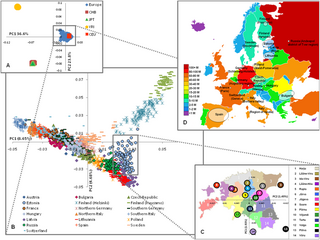
Genetic studies show that Russians are closest to Poles, Belarusians, Ukrainians and to other Slavs as well as to Estonians, Latvians, Lithuanians, Hungarians.
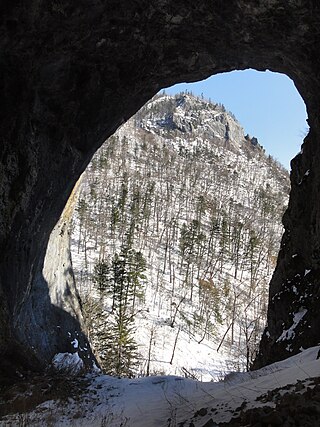
Chertovy Vorota Cave, also known as Devil's Gate Cave is a Neolithic archaeological site located in the Sikhote-Alin mountains, about 12 km (7 mi) from the town of Dalnegorsk in Primorsky Krai, Russia. The karst cave is located on a limestone cliff and lies about 35 m (115 ft) above the Krivaya River, a tributary of the Rudnaya River, below. Chertovy Vorota provides secure evidence for some of the oldest surviving textiles found in the archaeological record.

In archaeogenetics, the term Ancient North Eurasian (ANE) is the name given to an ancestral component that represents the lineage of the people of the Mal'ta–Buret' culture (c. 24,000 BP) and populations closely related to them, such as the Upper Paleolithic individuals from Afontova Gora in Siberia. Genetic studies also revealed that the ANE are closely related to the remains of the preceding Yana Culture (c. 32,000 BP), which were dubbed as 'Ancient North Siberians' (ANS), and which either are directly ancestral to the ANE, or both being closely related sister lineages, sharing a common ancestral source population. The Ancient North Eurasians are deeply related to Paleolithic and Mesolithic European hunter-gatherers, but also derive a small amount of their ancestry from a deep East Eurasian source, which they received in Siberia.

In archaeogenetics, the term Western Hunter-Gatherer (WHG), West European Hunter-Gatherer, Western European Hunter-Gatherer, Villabruna cluster, or Oberkassel cluster is the name given to a distinct ancestral component of modern Europeans, representing descent from a population of Mesolithic hunter-gatherers who scattered over Western, Southern and Central Europe, from the British Isles in the west to the Carpathians in the east, following the retreat of the ice sheet of the Last Glacial Maximum.
This article summarizes the genetic makeup and population history of East Asian peoples and their connection to genetically related populations, as well as Oceanians and partly, Central Asians and South Asians, which are collectively referred to as "East Eurasians" in population genomics.

In archaeogenetics, the term Ancient Northeast Asian (ANA), also known as Amur ancestry, is the name given to an ancestral component that represents the lineage of the hunter-gatherer people of the 7th-4th millennia before present, in far-eastern Siberia, Mongolia and the Baikal regions. They are inferred to have diverged from Ancient East Asians about 24kya ago, and are represented by several ancient human specimens found in archaeological excavations east of the Altai Mountains. They are a sub-group of the Ancient Northern East Asians (ANEA).

In archaeogenetics, the term Ancient Paleo-Siberian or Paleo-Siberian is the name given to an ancestral component that represents the lineage of the hunter-gatherer people of the 15th-10th millennia before present, in northern and northeastern Siberia. The Ancient Paleo-Siberian population is thought to have arisen from an Ancient East Asian lineage, which diverged from other East Asian populations sometimes between 26kya to 36kya, and subsequently came into contact and merged with the Ancient North Eurasians (ANE) sometimes between 20kya to 25kya. The source for the East Asian component among Ancient Paleo-Siberians is to date best represented by Ancient Northern East Asian populations from the Amur region older than 13,000 years, such as AR19K and AR14K, and before the Devil's Cave Ancient Northeast Asian specimens.

In archaeogenetics, Ancient Southern East Asian (ASEA), also known as Southern East Asian (sEA), is an ancestral lineage that is represented by individuals from Qihe Cave in Fujian and Liangdao Island in the Taiwan Strait as well as Guangxi. Ancient Southern East Asian ancestry significantly contributed to the genetic makeup of modern populations in East Asia, Mainland Southeast Asia, Insular Southeast Asia, and Oceania, and is commonly associated with the Neolithic expansion of early Austronesian and Austroasiatic speakers that occurred more than 4,000 years ago.



